This is one installment in a team effort by The Cleveland Fan, highlighting the top local sports figures by jersey number. Please weigh in with your thoughts, on the Boards. As David Letterman would say, “For entertainment purposes only; please, no wagering.”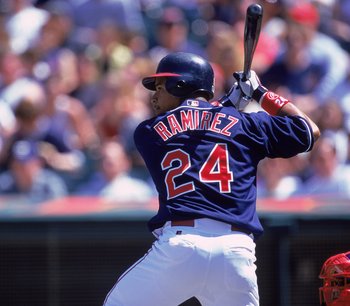 It’s tough to pass over a Hall of Fame pitcher who won 300 games and was a mainstay of one of baseball’s greatest pitching staffs when you set out to select the best player to wear #24 in a Cleveland uniform. But that’s what happened to Early Wynn, the right-hander who spent ten seasons in Cleveland, and picked up more than half of those 300 wins with the Tribe.
It’s tough to pass over a Hall of Fame pitcher who won 300 games and was a mainstay of one of baseball’s greatest pitching staffs when you set out to select the best player to wear #24 in a Cleveland uniform. But that’s what happened to Early Wynn, the right-hander who spent ten seasons in Cleveland, and picked up more than half of those 300 wins with the Tribe.
This series has already recognized several players from that “other era” of baseball success on Lake Erie...recognizing as this town’s best, names like Avila, Averill, Boudreau and Feller among others, from the 40’s and 50’s teams that we’ve only read about. But some of those guys didn’t have competition like Manny Ramirez.
If you try to recall the players drafted and developed by the Indians in the last few decades who turned out to be bonafide “stars” - if only for a while - it’s a pretty short list: Belle, Thome, Sabathia...and Manny Ramirez. In that respect, the kid from Santo Domingo, via New York City, was homegrown. He was all ours...till he wasn’t anymore.
Manny’s immense talent as a hitter exploded right before our eyes, in front of five straight seasons of nothing but sellout crowds. His career in Cleveland coincided with the most successful era of Indians baseball in our memory. Even as he was surrounded by other stars on the Indians teams of the 90’s, it was obvious from the start that he was a special player. That’s why Manny Ramirez is an easy choice at #24.
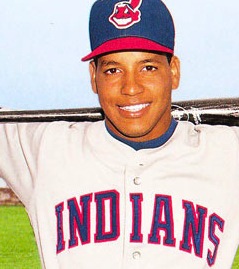 Like other Indians standouts before and since, Manny grabbed the brass ring when it came around for him during his stint in Cleveland, and he had 200 million good reasons for going to Boston when he did. Before he finally wore out his welcome in Beantown, he had a batting title, two World Series rings, and had become the all-time major league leader in postseason home runs. But he had also tainted his considerable accomplishments over the first 16 years in major league baseball by getting caught using performance-enhancing drugs.
Like other Indians standouts before and since, Manny grabbed the brass ring when it came around for him during his stint in Cleveland, and he had 200 million good reasons for going to Boston when he did. Before he finally wore out his welcome in Beantown, he had a batting title, two World Series rings, and had become the all-time major league leader in postseason home runs. But he had also tainted his considerable accomplishments over the first 16 years in major league baseball by getting caught using performance-enhancing drugs.
Somehow the drug suspensions, the often lackadaisical attitude, and the occasionally boorish behavior have never seriously diminished Manny’s fan appeal...certainly not in Cleveland, where his tenure predated those issues. Sometimes for better, often for worse, it seemed Manny Ramirez never wanted to grow up, but it is his enduring boyishness that has always made him a fan favorite.
---
Baby Bull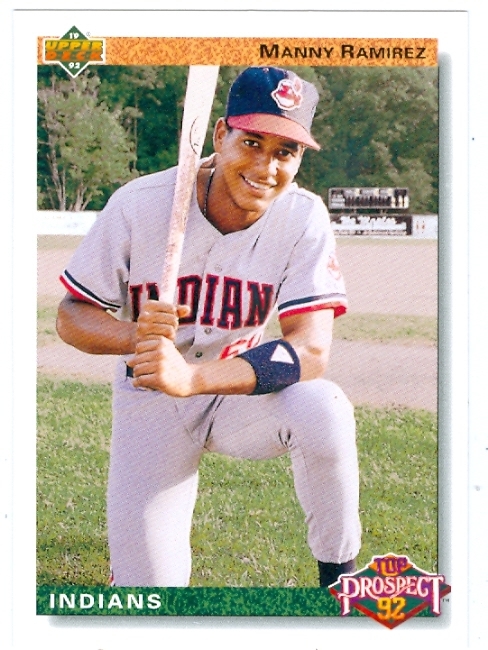 Manuel Aristides Ramirez was born in 1972 in the Dominican Republic, where he grew up playing baseball on the same Santo Domingo fields that produced Jose Bautista, Adrian Beltre, Albert Pujols, David Ortiz and so many other major leaguers. His grandmother immigrated to America in 1974, and nine years later she helped arrange a job as a seamstress for Manny’s mother in the Washington Heights neighborhood of Manhattan. The 11-year old and his sisters stayed behind with relatives when his parents moved to New York City in 1983, but the kids followed two years later, and Manny quickly became a sandlot sensation as a teenager in the big city.
Manuel Aristides Ramirez was born in 1972 in the Dominican Republic, where he grew up playing baseball on the same Santo Domingo fields that produced Jose Bautista, Adrian Beltre, Albert Pujols, David Ortiz and so many other major leaguers. His grandmother immigrated to America in 1974, and nine years later she helped arrange a job as a seamstress for Manny’s mother in the Washington Heights neighborhood of Manhattan. The 11-year old and his sisters stayed behind with relatives when his parents moved to New York City in 1983, but the kids followed two years later, and Manny quickly became a sandlot sensation as a teenager in the big city.
The Indians used the 13th pick in the 1991 draft on the 19-year old outfielder from George Washington High School. Ramirez had hit .650 in his third year at Washington, with 14 homers in 22 games, and was named the New York City Public School Player of the Year. He signed as a professional without graduating, and proceeded to rocket through the Indians farm system.
Assigned to rookie-league Burlington in ‘91, Ramirez became the Appalachian League MVP. In 1992 he took the Carolina League by storm at Kinston, and was named that circuit’s “Most Exciting Player” by Baseball America. He split the 1993 season between AA Canton and AAA Charlotte in the Indians’ system, and by year end was named Minor League Player of the Year by BA, after combining to hit .333, with 31 homers and 115 RBI in 129 games.
---
Homecoming at Yankee Stadium
It couldn’t have been a coincidence that Indians management called Manny up to make his major league debut one game before the Indians were scheduled to travel to New York for a series with the Yankees in early September of 1993. Ramirez had gone 0-4 in his first big league game against the Twins in Minneapolis on September 2nd, but his family, friends and fans knew that their favorite son was coming home the next night, and Yankee Stadium was ready. 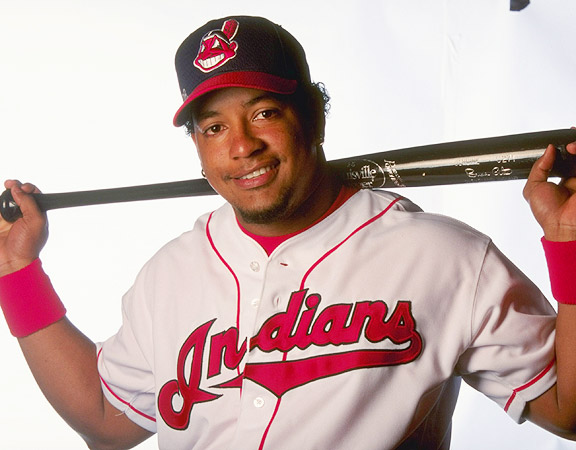 A raucous throng of Manny-backers from his Washington Heights neighborhood gathered that Friday night in the Bronx, with cowbells and whistles at the ready to cheer on their 21-year old hero, and Manny put on an unforgettable show for them in his second major league game.
A raucous throng of Manny-backers from his Washington Heights neighborhood gathered that Friday night in the Bronx, with cowbells and whistles at the ready to cheer on their 21-year old hero, and Manny put on an unforgettable show for them in his second major league game.
In his first at-bat he lined the ball deep to left field for his first major league hit while his cheering section erupted in wild celebration. Manny broke into his home run trot, not realizing that the ball had bounced over the wall, and he had to sheepishly retreat to second base with a ground rule double. He flied out in his second at-bat, but in the 6th, he crushed a home run to left off of Melido Perez, re-igniting the revelry in the Manny section. Back home in Cleveland, for the first time ever, Tribe fans were watching people cheering wildly at Yankee Stadium...and loving it.
As if the script writers hadn’t done enough already, Manny came to the plate once more that Friday night, and he sent his fans into total delirium with a second bomb to left field, this one a no-doubter line drive deep into the seats. 3 for 4, with two homers and a double...and the man some people say is the greatest right-handed hitter of all time was off and running. Well....jogging.
---
The Jacobs Field Years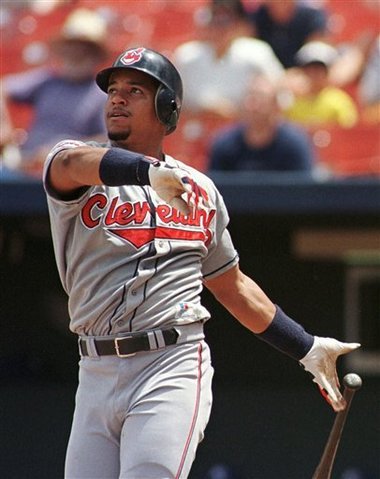 Manny hit .269, with 17 homers and 60 in the strike-shortened 1994 season, playing in 91 of the team’s 113 games, and finishing second in the Rookie of the Year voting to the forgettable Bob Hamelin of the Royals. He hit seventh in that bruising Tribe lineup, (four of that team’s regulars, Belle, Murray, Thome and Ramirez would combine for 2,052 career home runs...and counting) and with 22 doubles, fully half of his 78 hits went for extra bases.
Manny hit .269, with 17 homers and 60 in the strike-shortened 1994 season, playing in 91 of the team’s 113 games, and finishing second in the Rookie of the Year voting to the forgettable Bob Hamelin of the Royals. He hit seventh in that bruising Tribe lineup, (four of that team’s regulars, Belle, Murray, Thome and Ramirez would combine for 2,052 career home runs...and counting) and with 22 doubles, fully half of his 78 hits went for extra bases.
The batting average and the power numbers climbed steadily over the next three seasons as the Indians went to the World Series twice in that span. Manny hit .308, .309, and .328 from 1995-97, averaging 30 homers and 102 RBI over the same period. Then he picked it up.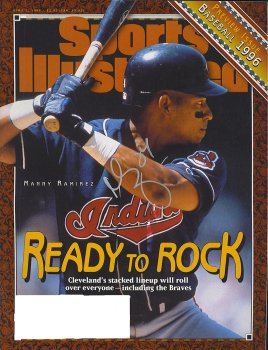 In 1998, Ramirez exploded with 45 homers and 145 RBI, to easily surpass his career highs in both categories, and in ‘99 he broke Hal Trosky’s team RBI record of 162, when he batted in 165 runs to lead the AL, while adding 44 more homers and hitting a cool .333. He led the AL in slugging (.663) and OPS (1.105) that year, and finished with an All-Star berth, a Silver Slugger Award and 3rd place in the MVP voting. He continued his tear in 2000, hitting a blistering .351, and again led the league in slugging (.697) and OPS (1.154).
In 1998, Ramirez exploded with 45 homers and 145 RBI, to easily surpass his career highs in both categories, and in ‘99 he broke Hal Trosky’s team RBI record of 162, when he batted in 165 runs to lead the AL, while adding 44 more homers and hitting a cool .333. He led the AL in slugging (.663) and OPS (1.105) that year, and finished with an All-Star berth, a Silver Slugger Award and 3rd place in the MVP voting. He continued his tear in 2000, hitting a blistering .351, and again led the league in slugging (.697) and OPS (1.154).
We were watching the best hitter in baseball right in our own backyard...and he hadn’t peaked yet. Along the way, there was no shortage of memorable moments. We could call them “Wow!” moments, as Dennis Eckersley famously put it after giving up this game-winning bomb to Manny in July of ’95. Here he is cracking a 3-run homer late in ‘99 to break the team RBI mark. His 1999 total of 165 was the highest in MLB in 61 years (Jimmie Foxx, 175 in 1938) and no one has matched it since.
---
The Bosox Era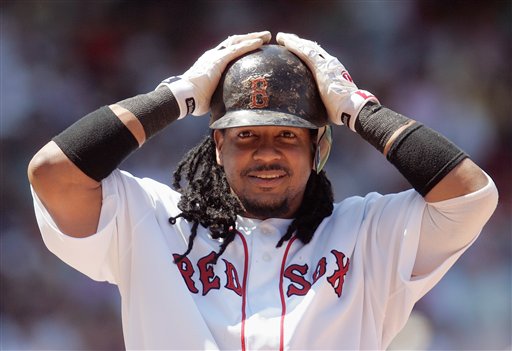 The Red Sox had their sights set on Manny after the 2000 season, and no amount of money the Indians could have come up with was going to keep Boston from one-upping them. Ramirez signed for eight years and $160 million, plus option years in 2009 and 2010 at $20 million-plus per season, for a total package of $200 million. Not bad for the son of an immigrant seamstress.
The Red Sox had their sights set on Manny after the 2000 season, and no amount of money the Indians could have come up with was going to keep Boston from one-upping them. Ramirez signed for eight years and $160 million, plus option years in 2009 and 2010 at $20 million-plus per season, for a total package of $200 million. Not bad for the son of an immigrant seamstress.
Manny helped bring the long-suffering fans of the Red Sox their first World Series title since 1918 when he was Series MVP in 2004 as Boston topped the St Louis Cardinals. His last three years in Cleveland began an 11-year streak of All-Star Game appearances that carried through his entire term in Boston. He won the AL batting title in 2002 with a .349 average, and he finished in the top 10 in the MVP voting eight straight years, overlapping his move from Cleveland to Boston.
Problem Child
The Red Sox would win the Series again in 2007, but the bloom was coming off Manny’s rose with Boston management, as his antics on and off the field were becoming more and more tiresome to the front office and to manager Terry Francona. Some were less serious than others, and those would serve to endear him to his fans more than irritate them. Such things as sneaking into the Green Monster between innings to take a leak, or to chat on a cell phone (see photo), were written off under the increasingly shopworn heading of “Manny being Manny”. 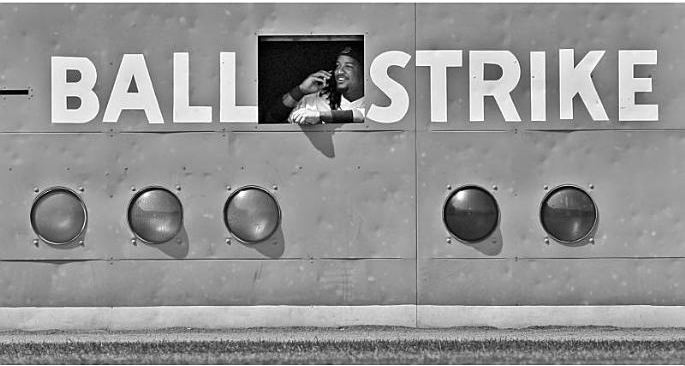
The Sox even placed Manny on waivers at one point during the height of his productivity, so frustrated were they by his frequent requests to be traded and his verbal shots at the front office, but there were no takers for the star outfielder with his tarnished reputation and his $20+ million salary. They finally traded him to the Dodgers midway through the final year of his 8-year deal in 2008, and he batted .322 for Los Angeles over three seasons, until they waived him in August of 2010.
Twilight
Ramirez bounced around to the White Sox and the Devil Rays in 2010 and 2011 between drug suspensions and reinstatements. He signed a minor league deal with Oakland in 2012, but would have been forced to serve a 50-game suspension before he could play, and instead asked for his release.
The final career numbers for Manny Ramirez, if they are indeed final, are stunning. A career .312 batting average, 555 home runs and 1,831 RBI. 2,574 hits, including 547 doubles. His 21 career grand slams rank 3rd all-time behind Alex Rodriguez and Lou Gehrig’s 23. His 29 postseason home runs are the standing major league record.
What looked a few years ago like a sure first-ballot Hall of Fame election will now be clouded by the same drug-era resistance that continues to keep McGuire, Bonds and Sosa out of Cooperstown. There is little doubt though, that Manny’s baseball skills merit his enshrinement with the game’s best ever. Surely he is the best player to have ever donned the #24 in Cleveland, Ohio.
----
Other Cleveland #24’s
Early Wynn - Indians - RHP - (1949-57; 1963)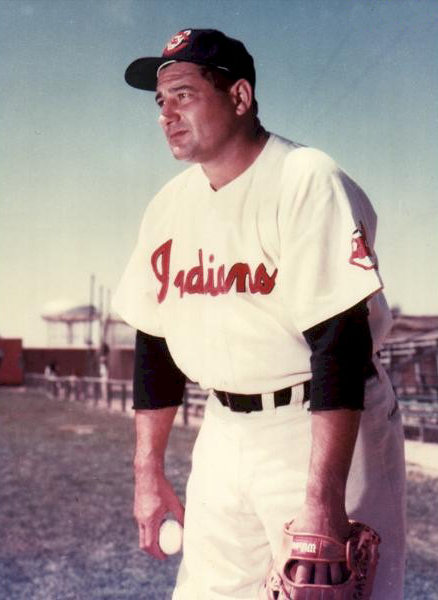 Wynn was a workhorse of a pitcher, competing in 691 major league games over 23 seasons, a record number of seasons for an AL pitcher. That included five 20-win seasons, 290 complete games and 49 shutouts. 164 of his victories came as a Cleveland Indian. On the heralded 1954 staff with Bob Feller and Bob Lemon, it was Wynn who led the AL in victories with 23. Traded to the White Sox after the ‘57 season, he won the Cy Young Award in 1959, at the age of 39, also winning the ERA title and again leading the AL in wins with a 22-10 record, as the Chisox edged the Indians for the pennant. He won back-to-back strikeout titles in 1957 and ‘58, becoming the first major leaguer to do it.
Wynn was a workhorse of a pitcher, competing in 691 major league games over 23 seasons, a record number of seasons for an AL pitcher. That included five 20-win seasons, 290 complete games and 49 shutouts. 164 of his victories came as a Cleveland Indian. On the heralded 1954 staff with Bob Feller and Bob Lemon, it was Wynn who led the AL in victories with 23. Traded to the White Sox after the ‘57 season, he won the Cy Young Award in 1959, at the age of 39, also winning the ERA title and again leading the AL in wins with a 22-10 record, as the Chisox edged the Indians for the pennant. He won back-to-back strikeout titles in 1957 and ‘58, becoming the first major leaguer to do it.
Wynn had a well-deserved reputation as a tough guy and a pitcher always ready to come inside to keep batters honest. He was once quoted as saying “I’d knock down my own grandmother if she dug in on me”. After five seasons in Chicago, and stuck on 299 wins, Wynn signed with the Indians for the 1963 season, mostly for the purpose of picking up win No. 300, which he finally pulled off after eight starts over two seasons. Wynn was inducted into the Baseball Hall of Fame in 1972.
-----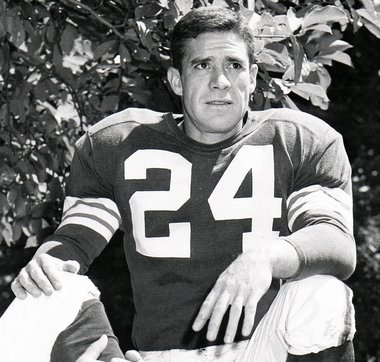 Warren Lahr - Browns - DB - (1948-1959)
Warren Lahr - Browns - DB - (1948-1959)
Lahr was a reliable and durable fixture in the Browns defensive backfield on the great teams of the late 40’s and 50’s. A native of Mt. Zion, PA, Lahr attended college in Cleveland, at Western Reserve University, and was selected by the Steelers in the 32nd round of the 1947 draft. He hurt his knee though, and was cut before he ever played a game. Paul Brown liked what he had seen of Lahr, and signed him as a free agent. Playing cornerback (or as they called it at the time, defensive halfback) Lahr had 44 career interceptions for the Browns, second only to Thom Darden in team history, returning five for touchdowns. Lahr’s interception in the final minute of the 1950 NFL Championship game, his second of the game, sealed the Browns’ 30-28 victory over the Rams. He worked as a Browns TV broadcaster from 1963-67, and left us way too soon, at age 45, in 1969.
----
Grady Sizemore - Indians CF - (2004-2011)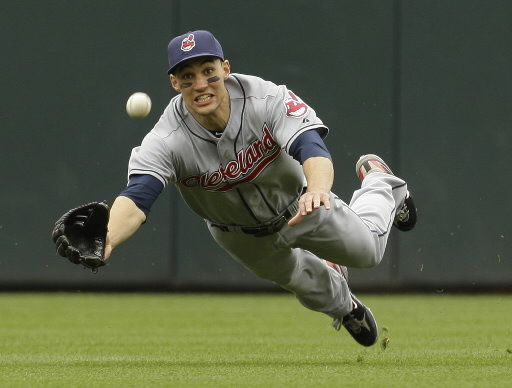 Sizemore has played all eight of his major league seasons as an Indian, but has seen his career devastated by injuries in recent years. It is ironic that the Tribe’s Iron Man from 2005-2008 (he played all but nine of the Indians 648 games over those four seasons), would struggle to stay healthy enough to be on the field for the next four years. Acquired from the Expos along with Brandon Phillips and Cliff Lee for Bartolo Colon in 2002, he debuted with the Indians in 2004, and quickly established himself as one of the most exciting young players in the game. Sizemore was a 3-time All-Star, and won two Gold Gloves and the 2008 Silver Slugger Award. From 2005-08, he averaged 27 home runs and 81 RBI, while playing spectacular defense in centerfield. Grady led the AL in runs scored and doubles in 2006, while playing in all 162 games. He missed the entire 2012 season with injuries, and is an unsigned free agent as the 2013 campaign draws near.
Sizemore has played all eight of his major league seasons as an Indian, but has seen his career devastated by injuries in recent years. It is ironic that the Tribe’s Iron Man from 2005-2008 (he played all but nine of the Indians 648 games over those four seasons), would struggle to stay healthy enough to be on the field for the next four years. Acquired from the Expos along with Brandon Phillips and Cliff Lee for Bartolo Colon in 2002, he debuted with the Indians in 2004, and quickly established himself as one of the most exciting young players in the game. Sizemore was a 3-time All-Star, and won two Gold Gloves and the 2008 Silver Slugger Award. From 2005-08, he averaged 27 home runs and 81 RBI, while playing spectacular defense in centerfield. Grady led the AL in runs scored and doubles in 2006, while playing in all 162 games. He missed the entire 2012 season with injuries, and is an unsigned free agent as the 2013 campaign draws near.
---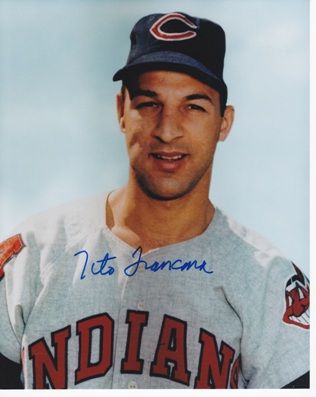 Tito Francona - Indians - OF - (1959-1964)
Tito Francona - Indians - OF - (1959-1964)
Francona was acquired by the Indians just before the 1959 season began, in a trade with the Tigers for Larry Doby. He had been the runner-up (tied with Cleveland’s Rocky Colavito) for Rookie of the Year when he came up with Baltimore in 1956, but had seen time with Chicago as well as the Tigers before arriving in Cleveland. Francona had what has to be considered his career year with the Tribe in that first season of ‘59. He batted a phenomenal .363, which was 105 points over his career best in his first three seasons. (His .363 average would have won the batting title, but he was 58 plate appearances short of qualifying) He hit 20 homers and drove in 79 runs as the Indians made a run at the AL pennant, ultimately finishing in 2nd, five games behind the White Sox. Francona finished 5th in the MVP balloting for his stellar campaign. Oddly enough, Tito’s son Terry Francona, now the Tribe manager, would also spend one season (1988) with the Indians, batting .311 in 62 games off the bench, and he too wore #24 for the Wahoos.
---
on Twitter at @dwismar
---